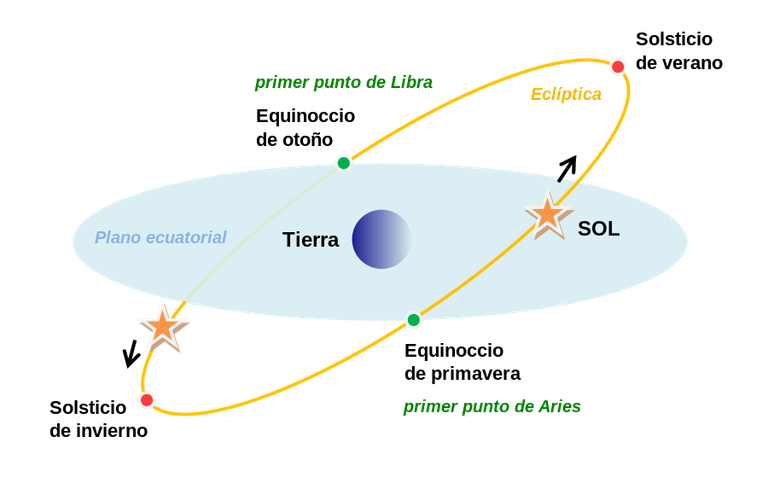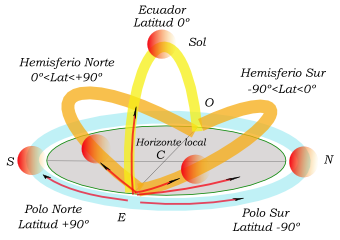March Equinox//Equinoccio de Marzo (ENG/ESP)

English Version
Greetings friends hivers and members of the community. Today March 20 is the astronomical phenomenon of the March equinox, which marks a change in the seasonal time of the Earth.
The equinox (from the Latin aequinoctium, that is, equal night) is the instant of time or moment of the year in which the sun is located just above the Earth's equator, or in other words, the moment in which the plane of the Celestial Equator intersects with the plane of the Ecliptic (plane of the Earth's orbit around the sun or apparent path that the sun travels over the sky). Due to this intersection of both planes, solar radiation strikes the Earth's equator perpendicularly, and its poles are located at the same distance from the sun, so that the length of day and night is approximately 12 hours over all parts of the world.

Taken from Link
At the time of the March equinox the sun is projected onto the so-called Aries point, traditionally so called because it was the constellation in front of which the Earth was located at the time of the March equinox more than 2000 years ago. At present, and due to the phenomenon of the precession of the Earth's axis, this equinoctial point has retrograded on the Ecliptic, placing the sun at this precise moment in the constellation of Pisces.

Taken from Wikipedia
The March equinox marks the beginning of spring in the Earth's northern hemisphere, as the sun moves from south declination to north declination, or from the southern hemisphere to the northern hemisphere, which means that the days gradually lengthen until the maximum length in June. In contrast, in the southern hemisphere, autumn begins, with the sun moving southward, resulting in a gradual shortening of the days during the season. At the north pole a day of 6 months duration begins, contrary to the south pole which enters a perpetual night of 6 months duration.

Taken from Link
On this day, the sun rises exactly on the east cardinal point, and sets on the west, traveling half a circumference over the sky during the day above the horizon, and the other half of the circumference during the night below the horizon. For an observer located just above the equator, the sun reaches the zenith perpendicularly overhead, traveling a vertical path.

Taken from Wikipedia
So friends, I wish you all a happy equinox day. I hope this post will be useful. Best regards.
Bibliographic source consulted:
Wikipedia
Link

Versión en Español
Saludos amigos hivers y miembros de la comunidad. En el día de hoy 20 de Marzo tiene lugar el fenómeno astronómico del equinoccio de marzo, lo cual marca un cambio en el tiempo estacional de la Tierra.
El equinoccio (del latín aequinoctium, esto es, noche igual) es el instante de tiempo o momento del año en el que el sol se sitúa justo sobre el ecuador de la Tierra, o dicho de otra forma, el momento en el que el plano del Ecuador Celeste se cruza con el plano de la Eclíptica (plano de la órbita de la Tierra alrededor del sol o camino aparente que recorre el sol sobre el cielo). Debido a esta intersección de ambos planos, la radiación solar incide perpendicularmente sobre el Ecuador de la Tierra, y sus polos se sitúan a la misma distancia del sol, por lo que la duración del día y la noche es de aproximadamente 12 horas sobre todos los lugares del mundo.

Tomada de Enlace
En el momento del equinoccio del mes de marzo el sol se proyecta en el llamado punto Aries, denominado así tradicionalmente por ser la constelación frente a la cual se situaba la Tierra en el momento del equinoccio de marzo hace más de 2000 años atrás. En la actualidad, y debido al fenómeno de la precesión del eje de la Tierra, este punto equinoccial ha retrogradado sobre la Eclíptica situándose el sol en este preciso momento en la constelación de Piscis.

Tomada de Wikipedia
El equinoccio de marzo marca el inicio de la primavera en el hemisferio norte de la Tierra, al pasar el sol de declinación sur a declinación norte, o del hemisferio sur al hemisferio norte, lo cual trae consigo que los días gradualmente vayan alargándose hasta el máximo de duración en el mes de junio. Por el contrario, en el hemisferio sur comienza el otoño, pasando el sol hacia el sur y trayendo como consecuencia un acortamiento gradual de los días durante la estación. En el polo norte comienza un día de 6 meses de duración, contrariamente al polo sur que entra en una noche perpetua de 6 meses de duración.

Tomada de Enlace
En este día, el sol sale exactamente por el punto cardinal este, y se pone por el oeste, recorriendo media circunferencia sobre el cielo durante el día sobre el horizonte, y la otra mitad de la circunferencia durante la noche bajo el horizonte. Para un observador situado justo sobre el Ecuador, el sol alcanza el cenit perpendicularmente sobre su cabeza, recorriendo una trayectoria vertical.

Tomada de Wikipedia
Así que amigos, les deseo a todos un feliz día de equinoccio. Espero resulte de utilidad este post. Saludos cordiales.
Fuente bibliográfica consultada:
Wikipedia
Enlace

Thanks for your contribution to the STEMsocial community. Feel free to join us on discord to get to know the rest of us!
Please consider delegating to the @stemsocial account (85% of the curation rewards are returned).
You may also include @stemsocial as a beneficiary of the rewards of this post to get a stronger support.
Thanks to you for the opportunity to share content in your community. Regards.